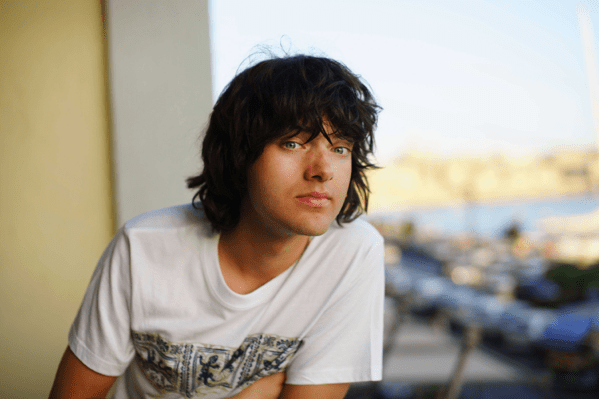“For society to progress, we should not only move forward but also cleanup after ourselves.”1

By NOAA | Courtesy of Wikimedia Commons
Over the last forty years, our oceans have been filling with tons of plastic debris. The plastic is carried by the ocean currents and it all converges in five major accumulation zones, commonly called “Garbage Patches.”2 Many scientists predict that if this problem is not solved, there will be major consequences. Garbage will block the sunlight in the oceans, resulting in many species of sea plants and animals dying. Moreover, the environment will be affected in such ways that the entire food chain of the world will suffer major changes. Dutch inventor Boyan Slat has come up with an idea to solve this problem.3
Boyan Slat is a 24-year-old Dutch inventor, who has been interested in engineering projects since he was very young. At the age of fourteen, he even set a Guinness World Record by launching 213 water rockets at the same time.4 When he was sixteen, he went diving in the waters of Greece and was so surprised to see more plastic underwater than fish. That was the moment when Slat began the idea of cleaning up the ocean. Over the last forty years, millions of tons of plastic have entered the oceans creating huge garbage patches. The largest such patch is located between Hawaii and California. After his trip to Greece, Boyan became obsessed with this problem. During high-school, all of his science projects were about understanding this problem and trying to solve the “million-dollar” question “why this cleanup is considered impossible?”5

After high-school, Boyan was invited to TEDtx to tell the world his idea. At first, his ideas didn’t seem to be really interesting to the public, so he went on with his life. He started working as an aerospace engineer in TU Delft, but he just couldn’t let go of his idea. But the simple thought of not being able to come up with a solution to this major problem was killing him. He was thinking about the terrible consequences, in several years, for the planet if no one did anything.6
After several months he came into the spotlight again because some news sites had picked up his TED speech and became interested in his story. Slat even dropped out of college to pursue his dream.7
He had always enjoyed solving problems and puzzles. But this time was going to be different. This time the puzzle was to get rid of the plastic in the oceans. He just had to find the perfect pieces to accomplish that. At the young age of eighteen, he founded a non-profit organization called The Ocean Cleanup, in order to develop new technology to tackle this almost impossible task.8
And this is when the real adventure began for Slat. Instead of picking up all the plastic bottles with nets, which according to experts it would cost millions of dollars and take thousands of years, his idea was to use the power of natural currents to gather plastic into long floating rubber barriers. But developing this great plan wasn’t an easy task. It required money, time, and many experts in different fields. In an interview, Slat said “When I started, I thought I would likely fail, and I still might, but considering the scale of the problem, it was important to at least try.”9
His ideas started coming together when several experts, such as engineers, oceanographers, recycling companies, and scientists volunteered to complete a study, which ended up indicating that the The Ocean Cleanup project had a feasible and viable method for removing large amounts of plastic. But this was only the first step. Slat still needed a lot of money to start the project. So his next step was to take his story and project to the rest of the world. He has since gained the support of 160 countries, 38,000 funders, and collected over 2 million USD. With this money, he was closer to accomplishing his dream, but, again, this was just another piece of a big puzzle.10

Later, The Ocean Cleanup started developing prototypes, then getting into trials, failing and learning from mistakes, and finally the got it right. They mapped an area of 3.5 million squared kilometers of plastic and marine debris, known as the “great pacific garbage patch.” After that, Slat gave an interview arguing that most people had an image of this patch as an island where you can practically walk on, but that couldn’t be more wrong. It stretches for millions of kilometers and it would take thousands of years to clean it up.11 So he targeted that area to clean first. The first Ocean Cleanup system was launched on September 8, 2018. He is hoping to clean up to 50% within five years.12
This amazing story is only getting started, so if you want to follow the progress of this project, you can follow their official organization page (www.theoceancleanup.com).
- The Ocean Cleanup, “The largest Cleanup history,” The Ocean Cleanup, June 6, 2017. Accessed September 8. www.theoceancleanup.com. ↵
- NOAA, “Great Pacific Garbage Patch,” National Geographic, June 5, 2015. Accessed September 8. https://www.nationalgeographic.org/encyclopedia/great-pacific-garbage-patch/. ↵
- U.S. Government Publishing Office, “Endangered status for North Pacific and North Atlantic Right Whales,” (Federal register: Vol. 73, No. 45. Thursday, 2008), 12024-12030. ↵
- Viveke Venema, “The Dutch boy mopping up a sea of plastic,” BBC News, October 17, 2017. Accessed September 7. https://www.bbc.com/news/magazine-29631332. ↵
- Susan Caminiti, “Thiel backing 22-year-old’s dream to clean up world’s oceans,” CNBC.com, April 22, 2017. Accessed September 5. https://www.cnbc.com/2017/04/20/thiel-benioff-backing-22-year-olds-dream-to-clean-up-worlds-oceans.html. ↵
- The Ocean Cleanup, “How it all began,” The Ocean Cleanup, June 6, 2017. Accessed September 8. www.theoceancleanup.com. ↵
- The Ocean Cleanup, “How it all began,” The Ocean Cleanup, June 6, 2017. Accessed September 8. www.theoceancleanup.com. ↵
- Susan Caminiti, “Thiel backing 22-year-old’s dream to clean up world’s oceans,” CNBC.com, April 22, 2017. Accessed September 5. https://www.cnbc.com/2017/04/20/thiel-benioff-backing-22-year-olds-dream-to-clean-up-worlds-oceans.html. ↵
- Viveke Venema, “The Dutch boy mopping up a sea of plastic,” BBC News, October 17, 2017. Accessed September 7. https://www.bbc.com/news/magazine-29631332. ↵
- The Ocean Cleanup, “Milestones,” The Ocean Cleanup, June 6, 2017. Accused September 8. www.theoceancleanup.com. ↵
- Marian Liu, “Great Pacific Garbage Patch Now Three Times the Size of France,” CNN, 23 Mar. 2018. Accessed September 6 2018. www.cnn.com/2018/03/23/world/plastic-great-pacific-garbage-patch-intl/index.html. ↵
- The Ocean Cleanup, “Milestones,” The Ocean Cleanup, June 6, 2017. Accessed September 8. www.theoceancleanup.com. ↵



78 comments
William Ward
Wow, a trash pile the size of Texas. That is terrible any way you look at it but it is great to hear about the youth, specifically Boyan Slat and his efforts to aid the clean up our beautiful planet. While students his age are worried about homework and playing videogames, Boyan is helping save the world without a mask and cape. Great story.
Damian Jennings
I can admit that I have previously and carelessly contributed to polluting the Earth, I agree with your introduction, instead of advocating to stop polluting we should encourage people to clean up the mess. Maybe incorporate a global clean up day in the calendar, that doesn’t seem like a bad idea. I had no idea that the waste ends up in the oceans to form massive islands.
Maisie Favila
Pollution is such a huge issue, especially in our oceans. The short time frame given to clean everything is tough although it could happen. I think mentioning the size comparison was a real eye opener especially to people who don’t really care about the issue. Although it’s good they’re taking action now, it shouldn’t be a growing problem. I also think that saying the garbage could be an island we could walk on was ridiculous. I hope this problem slowly becomes better. Overall, this article was well written and I learned a lot.
Julia Deais
This is a really good idea. I hate how we are polluting the earth and being the cause of sea animals, in this case, dying and in some cases going extinct. However, I did not know that there was a huge trash pile in the middle of the ocean caused by the currents. It is crazy to me how it is larger than the state of Texas. This was a really well written article.
Lamont Traylor
I think that the current state of the earth and its location for garbage is awful. It’s sad to say but humans are terrible at taking care of the planet and the environment because we all do things that make us comfortable but unfortunately it messes up the environment at the same time. I hope that we figure out a way to get off the planet and find another because the way we live, the planet won’t last long.
Crystal Baeza
This article was a great read and hopefully got the eye of many others to realize how bad we are hurting Earth. It’s unfortunate it’s taken us this long to realize the damage we are causing and I’m hopeful this project with follow through with success. It’s time we also change the ways we are disposing our trash and avoid these problems in the future. It won’t be helpful if they are cleaning up the oceans but we are continuing adding more mess for them to clean up.
Eloisa Sanchez Urrea
When we are not directly affected by a problem it is easy to forget about it or feel that it is not our responsibility. I think it is inspiring that at such a young age Boyan Slat was able to become so passionate about our waste problem that he decided to take action. His plan to find an innovative, effective way to collect trash was by no means easy, but still he was determined to at least make an effort. I think this article did a good job of detailing Slat’s journey and dedication.
Daniela Duran
It is horrific how we go about innovating in so many ways, but forget about our own planet. It is especially concerning how our rubbish ends up affecting the lives of our marine animals, hence affecting all food chains! I believe that what Slat is doing is truly admirable, not only because of the scale of his project, but also because of the passion he has put into it. If we only had more people like him, we would definitely be able to change our world. I hope his project goes well in the future. This was a great article and fun to read!
Cooper Dubrule
Waste management is a very important aspect of dealing with population growth and with population growth being inevitable, it is vital to a properly functioning society. I don’t think we can clean all the trash in a span of five years however I do think this plan poses great start as to how to go about cleaning the great pacific garbage patch.
Sabrina Hsu
I think what Boyan Slat has started is so important especially with how much pollution we have in our oceans. I had never heard of the garbage patches before but I knew how badly polluted our oceans are. It’s kind of sad that he’s only 24 years old and is doing all of this, when our oceans have been polluted for a long time, and no one else has done as much as he is doing. I really hope The Ocean Cleanup is successful because the pollution is effecting wildlife and will continue to effect them and our own lives.